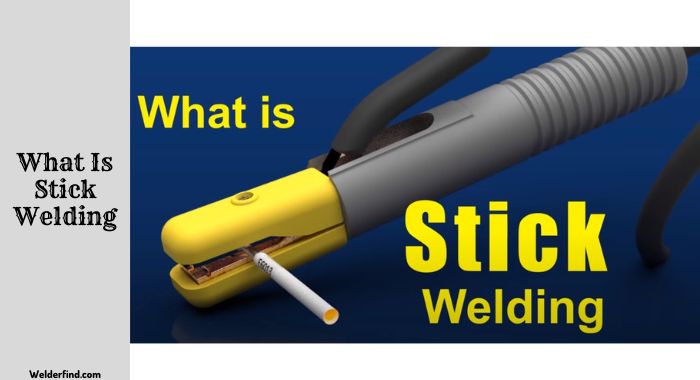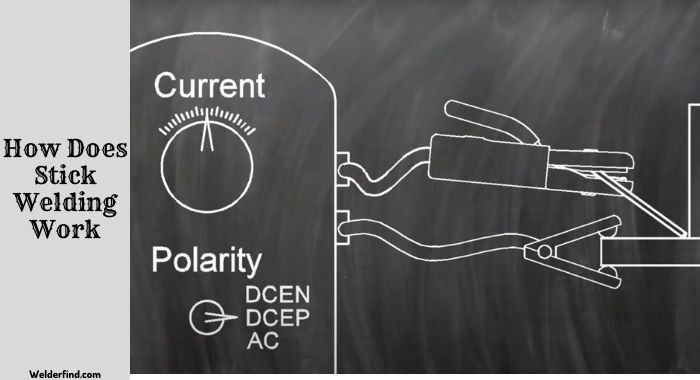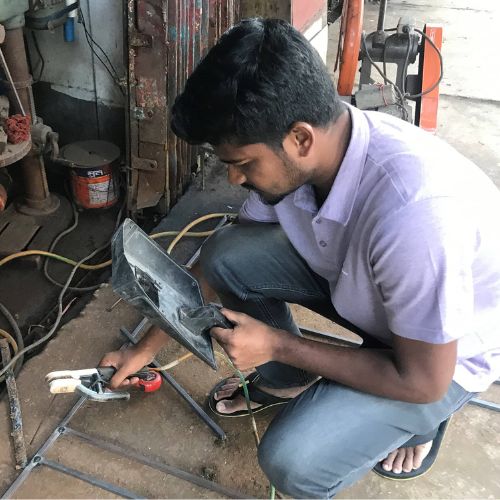A British chemist and inventor, Sir Humphry Davy, invented stick welding in 1800. But it was first used in the Cabot Laboratory in France to join lead plates.
But how does stick welding work? This unique welding process is easier to learn than TIG welding but more complex than MIG welding.
If you are considering buying and using a stick welder, you must know how to use this welding tool and its functionalities.
This article will give you a complete overview of this topic.
What Is Stick Welding?

Stick welding is a particular type of welding that is widely used in various arc welding procedures.
This unique welding approach involves utilizing a consumable rod with a flux coating to perform welding tasks.
Welders use this metal rod or stick as filler material in the shielded metal arc welding form weld.
You don’t need any gas in stick welding because the rod or electrode used in the welding procedure contains inert materials that release inert gases to protect the molten metal.
How Does Stick Welding Work?
Wondering how to do stick welding? Here is the step-by-step guideline to perform welding tasks perfectly.
- Step: 01—Cleaning The Welding Area
The first substantial job is cleaning the welding area correctly. You can use a versatile and effective tool like a wire brush to remove dust, dirt, grime, rust, etc.
Poor cleaning will result in welding defects. It may lead to weaker welds that look like junk.
Another important thing is cleaning the work clamps spot perfectly. A dirty clamp may cause an unstable arc and inconsistent welds and lead to overheating in the clamp.
- Step: 02—Setting The Ideal Voltage And Current
The next task is implementing the right setting. You want to consider two essential factors: metal thickness level and electrode type.
When welding thicker metals, you need welding rods with positive polarity. It should achieve a penetration of at least 50% of the thickness of the base metal.
However, you need electrodes with negative polarity to weld thinner metals. They provide shallower penetration to avoid overheating and damaging the metal.
Make sure to set up the correct, current level and amperage based on the instruction manual.
Excessively lower amperage will make the electrode sticky. You will struggle to maintain a perfect arc length as the arch will be displaced.
You can’t also use too much current. Otherwise, it will cause over-brightening or glowing rods.
- Step: 03—Keeping The Right Welding Position
After setting up everything perfectly, you can start the arc. Use both hands to grip the stick holder and maintain the proper position and angle.
Ensure to maintain a perfect welding position to see the welding pool, electrode, and workpiece clearly.
Initiating an electric arc requires placing the electrode’s tip against the metal. This will help you create a pool of molten metal that solidifies to form a strong joint.
Make sure slightly lift and pull the arc slightly after it is created. This will help you maintain the arc length and prevent it from sticking to the metal.
- Step: 04—Maintaining The Correct Travel Angle
Travel angle in stick welding can be anywhere from 0 to 15 degrees, depending on the applications.
For example, the welding position should be flat, overhead, or horizontal when you use the backhand or drag technique.
You want to hold the welding rod perpendicularly while maintaining 5 to 15 degrees of angle.
But when using the forehand or push technique, the angle should be 0 to 15 degrees.
You should also adjust your body position and posture, as it can make a difference in your welding result.
- Step: 05—Keeping Appropriate Travel Speed
Various welding speeds of travel can influence the outcome of welding. It can’t be too fast or slow. Otherwise, it will deteriorate the welding quality.
For example, too fast travel speed will generate less heat. This will decrease weld metal deposits and increase the likelihood of porosity.
In contrast, a too-slow travel speed will increase the weld’s heat. It will lead to too much wide weld beads and lousy penetration. Thinner items may burn due to higher heat.
- Step: 06—Maintaining The Right Welding Technique
How long have you been practicing welding? Your welding skills directly affect the quality and strength of the weld.
Poor welding techniques or lack of skill can result in weak, brittle, and unreliable welds that can fail under stress or pressure.
If you are new in the welding field, follow an experienced welder to learn how to adjust their technique to different materials, welding positions, and welding processes.
Follow a circular motion to produce smoother and wider weld beads. But make sure to maintain a consistent arc length.
Is your welding metal 0.25-inch thick? If so, avoid weaving motion that involves moving the electrode back and forth in a zig-zag pattern. It will cause poor penetration.
Instead, you want to move the electrode from side to side to evenly distribute the heat and create a broader bead that gives the weld more strength and stability.
Equipment Used In Stick Welding
The followings are the vital equipment you need to perform stick welding successfully.
Stick Welder
The first important piece of equipment is the stick welder. Consider its amperage, voltage range, duty cycle, portability, power source, and price.
Safety Equipment
Wear necessary safety equipment specially designed for welding, such as helmets, gloves, jackets or aprons, goggles, respirators, earplugs, earmuffs, fire extinguishers, welding curtains, etc.
Ground Clamp
Plug in the ground clamp to the stick welding machine and clamp it to the workpiece to avoid getting an electrical shock when touching the two points.
Slag Removing Tools
A slag removal tool comes in handy to constantly track the weld quality. It allows you quickly slag from welded components and achieve high-quality welds.
Electrodes Or Rods
Welders usually use E-6010, E-6011, E-6013, E-7018, and E-7024 electrodes to weld metals, which are 1/8- to 5/32 inches thick.
Stick Welding Safety Requirements
When it comes to stick welding, you want to ensure optimal safety to minimize the risk of accidents and injuries.
Make sure to use all the safety equipment already mentioned. Work in a properly ventilated area to eliminate health hazards such as gases, fumes, and dust.
Get rid of any flammable materials from the welding zone to avoid fire-hazardous issues.
What Type Of Project Work In Stick Welding
Stick welding is used for various industries, such as construction, manufacturing, steel fabrication, field repair, petroleum, shipbuilding & marine, structural welding, etc.
Welders use this welding method to weld bridges and repair broken or damaged parts of machinery, automotive components, outside storage tanks, pipelines, etc.
Advantages Of Stick Welding
- Stick welding is easy to learn and suitable for indoors and outdoors.
- You don’t need any separate shielding gas.
- Stick welding works well with various sizes and types of electrodes.
- Its equipment is inexpensive and running costs are lower.
- The machine is relatively lightweight and compact to ensure portability.
Disadvantage Of Stick Welding
- Stick welding produces a good amount of smoke and fumes.
- It is a bit complicated to perform stick welding in vertical and overhead positions.
- Compared to other welding processes, it is a bit slower.
Last Words
Stick welding is an excellent choice for working with thicker materials. You can use this particular welding method to handle various types of projects.
But you must clearly know, “How does stick welding work?” That’s what we covered in this post.

